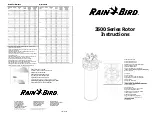
1
Introduction
Ionization Modes
Thermo Scientific
TSQ Quantum XLS Series User Guide
3
The mass spectrometer’s triple-stage mass analyzer performs either one or two stages of mass
analysis:
• The mass spectrometer is operated as a conventional mass spectrometer with one stage of
mass analysis. The ion source ionizes the sample and the ion products are subjected to
mass analysis in the first rod assembly. The second and third rod assemblies transmit the
resulting mass-selected ions to the ion detection system.
1
• The mass spectrometer is operated as a tandem mass spectrometer with two stages of mass
analysis. The ion source ionizes the sample and the ion products are mass analyzed by the
first rod assembly. In this case, however, mass-selected ions exiting the first rod assembly
collide with an inert gas in the second rod assembly and fragment to produce a set of ions
known as product ions. (A chamber called the collision cell surrounds the second rod
assembly. The collision cell can be pressurized with an inert gas.) The product ions
undergo further mass analysis in the third rod assembly to detect selected ions. Two stages
of mass analysis yield far greater chemical specificity than a single stage can achieve,
because of the system’s ability to select and determine two discrete but directly related sets
of masses.
In a first stage of mass analysis, you can use the mass spectrometer to elucidate the structures
of pure organic compounds and the structures of the components within mixtures.
Furthermore, in a second stage of mass analysis, the mass spectrometer can fragment and
separate each ionic fragment of a molecule formed in the ion source to build up an entire
structure for the molecule, piece by piece. As a result, the TSQ Quantum XLS Series systems
make investigating all pathways for the formation and fragmentation of each ion in the mass
spectrum possible.
The two stages of mass analysis, with resultant reduction of chemical noise in the final mass
spectrum, allow for very selective and sensitive analysis.
Each sequence of single or triple-stage mass analysis of the ions is called a scan. The mass
spectrometer uses several different scan modes and different scan types to filter, fragment, or
transmit ions in the mass analyzer. Along with the ionization and ion polarity modes, the
ability to vary the scan mode and scan type affords you great flexibility in the instrumentation
for solving complex analytical problems.
Ionization Modes
The specific process used to ionize the analyte is referred to as the ionization mode. You can
operate the TSQ Quantum XLS Series mass spectrometers in either of two ionization modes:
•
•
1
You can also use the instrument as a single-stage mass spectrometer by transmitting the ions through the first
and second rod assemblies followed by mass analysis in the third rod assembly.
















































